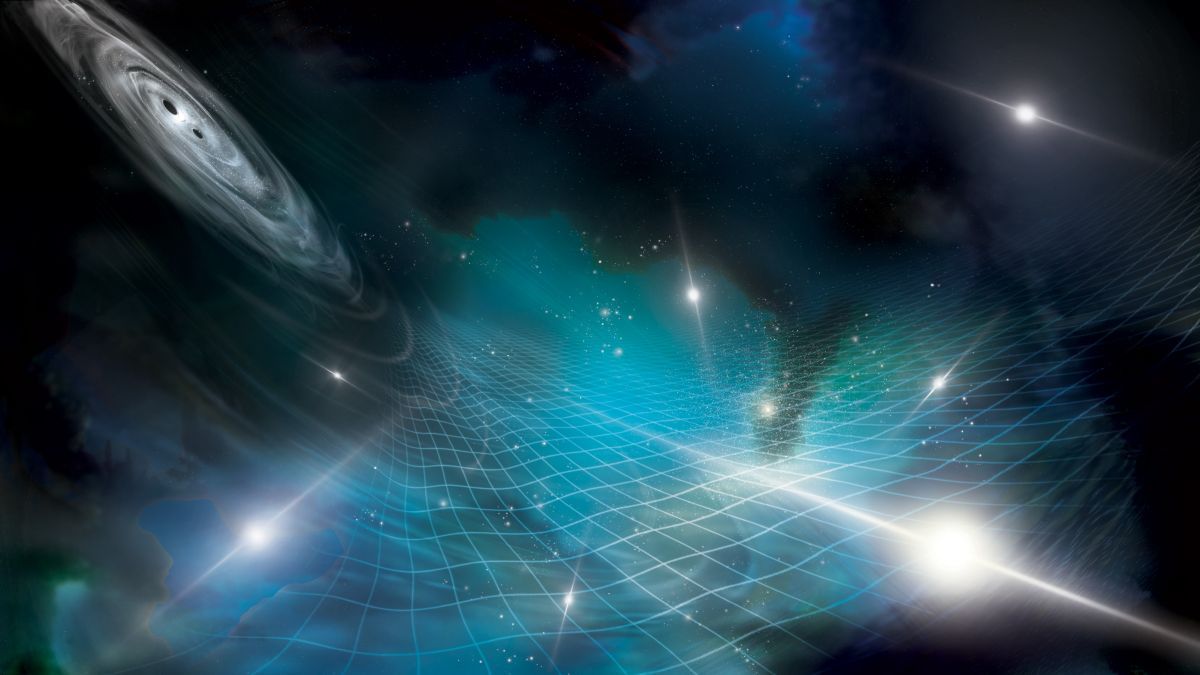The universe is rippling with a faint 'gravitational wave background' created by colliding black holes, huge international study suggests
On June 29, five independent teams of radio astronomers published a series of papers presenting evidence that the universe is filled with gravitational waves created by colliding supermassive black holes.
The North American , European, Indian , Chinese and Australian teams monitored rapidly spinning dead stars known as pulsars to gather information about the gravitational waves.
"The results presented today mark the beginning of a new journey into the Universe to unveil some of its unsolved mysteries," Michael Keith a lecturer in astrophysics at the University of Manchester's Jodrell Bank Centre for Astrophysics and member of the European Pulsar Timing Array (EPTA), said in a statement .
Gravitational waves are ripples in the fabric of space-time that travel across the universe at the speed of light. Although Albert Einstein predicted their existence in 1916, it took almost a full century before the space-time vibrations were detected on Earth by the Laser Interferometer Gravitational-Wave Observatory (LIGO) collaboration in 2015.
Gravitational waves cause space to stretch and compress. By carefully measuring how objects in space change their positions relative to one another, scientists can infer the passing of a gravitational wave. LIGO monitored how the length of 2.5-mile-long (4 kilometers) tunnels changed by less than one-thousandth the size of a proton. Thanks to this engineering feat, the 2015 researchers detected gravitational waves produced by black holes that are tens of times as massive as the sun.
But to detect the low-frequency rumble of gravitational waves produced by supermassive black holes billions of times more massive than the sun requires a detector much larger than the size of Earth.
The Very Large Array in New Mexico was one of several radio telescope facilities that carried out the 15-year gravitational wave search. (Image credit: NRAO)
A galactic-scale gravitational wave detector
Astronomers measure how the distance between Earth and pulsars in the Milky Way changes because of gravitational waves that travel through our galaxy. This is known as a pulsar timing array.
Pulsars are remnants of supernova explosions: dying stars that collapse into highly magnetized and rapidly spinning neutron stars that continuously emit beams of electromagnetic radiation. The beams can sweep across space several hundred times per second. When some of them point toward Earth, they appear as highly regular radio pulses.
"Pulsars are excellent natural clocks," David Champion , a scientist at the Max Planck Institute for Radio Astronomy and EPTA, said in the statement. "We use the incredible regularity of their signals to search for minute changes in their ticking to detect the subtle stretching and squeezing of space-time."
British astronomer Jocelyn Bell Burnell observed the first pulsar in 1967. During the last 15 years, radio astronomers from the different teams have carefully monitored the pulses from a total of around 100 rapidly spinning pulsars.
"Pulsars are actually very faint radio sources, so we require thousands of hours a year on the world's largest telescopes to carry out this experiment," said Maura McLaughlin a professor of physics and astronomy at West Virginia University and the North American Nanohertz Observatory for Gravitational Waves (NANOGrav), said in a separate statement .
Rather than detecting individual gravitational waves that pass through the Milky Way, the five different teams study the entire background of low-frequency gravitational waves that fill the cosmos. The slow oscillations in the distances between the pulsars and Earth are extremely tiny — on the order of one part in a thousand million million — and astronomers have to carefully model all possible sources of noise that also appear in their observations, including clouds of gas and dust that the radio pulses travel through, the motion of Earth through space, as well as the displacement of the telescopes due to the movement of the continents they stand on.
The 15-year-long cosmic hunt has finally revealed the first hints of the gravitational wave signal likely created by supermassive black holes. "When I saw the gravitational wave pattern emerge, I got butterflies," Stephen Taylor from Vanderbilt University and chair of the NANOGrav collaboration said in a press briefing.
A sharpened up image of the black hole M87*, captured at the fullest resolution of the Event Horizon Telescope. (Image credit: Medeiros et al. 2023)
A supermassive origin?
Although the signal does not quite yet reach the golden standard for detection set by the scientific community, the astronomers feel confident that their result gives "compelling evidence" for a gravitational wave background likely produced by pairs of gigantic black holes.
Most galaxies have a gigantic black hole at their center (such as the Milky Way ’s own Sagittarius A* and the distant M87* recently imaged by the Event Horizon Telescope). These cosmic monsters have a mass ranging from a few hundreds thousand times the sun's mass to an astounding tens of billions times that of the sun. As galaxies collide, their gigantic black holes can come in the vicinity of one another. As they circle each other in a slow but incessant cosmic waltz, they emit the low-frequency gravitational waves that the astronomers have been searching for.
"Now we finally have strong evidence that many of these extremely massive and close binaries do exist. Once the two black holes get close enough to be seen by pulsar timing arrays, nothing can stop them from merging within just a few million years," Luke Kelley , assistant adjunct professor of astronomy at University of California, Berkeley, and chair of NANOGrav's astrophysics group, said in a statement.
Intense physical processes that happened after the Big Bang could also contribute to the gravitational wave background. As the teams combine their data sets and continue their observations, they will investigate in more detail both the properties of the gigantic black hole pairs and maybe even the exotic physics in the early universe.
"Our combined data will be much more powerful," said Taylor. "We're excited to discover what secrets they will reveal about our Universe."
Source: Livescience.com


